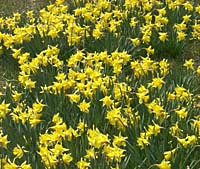Fall a Good Time to Prevent Tulip and Daffodil Disease
Fall a Good Time to Prevent Tulip and Daffodil Disease

Those who look forward to spring often plant tulips and daffodils in the fall knowing that their blooms will signify the end of winter and provide a colorful show to welcome the fresh season. But, these flowers are also susceptible to decay caused by fungi, nematodes and bacteria, but with careful planning, growers can minimize spring loss.
“Kentucky gardeners and landscapers need to be selective, not only for flower color, form and time of bloom, but also for flower bulb health,” said John Hartman, Extension plant pathologist for the University of Kentucky College of Agriculture.” Recognizing diseased bulbs and using control measures in the fall, when they are planted, is important to producing healthy flowers in the spring.”
Diseases of tulip and daffodil bulbs include basal rot, black slime or blackrot, blue mold, crown rot or southern wilt. Also, various plant pathogenic nematodes and bacteria can cause discolored patches and a soft and spongy decay of the bulbs.
Hartman said there are several common-sense precautions growers can take when selecting and planting tulips and daffodils to avoid bulb rots.
“Growers should buy bulbs from a reliable source,” he said. “Unfortunately cheap bulbs are sometimes cheap because they are not in the best health.”
Hartman went on to say that growers should use crop rotation in flower beds so the soil inhabiting pathogens do not build up to high levels.
“When we talk about the planting site, the soil should be well-aerated and well-drained,” Hartman emphasized. “Avoid using excessive amounts of nitrogen, phosphorous, or organic matter.”
Since soil-borne fungi more easily invade injured bulbs, Hartman said growers should avoid unnecessary injury to the bulbs before planting.
“Sort through the bulbs and discard any that are partly decayed,” he suggested. “Especially look at the neck and basal areas of the bulbs. One way to discover decayed bulbs is to place them in water. Healthy tulip bulbs will sink, while decayed bulbs will float.”
Hartman said the problem with the immersion detection method is that the dipping water can become contaminated with spores from decaying bulbs and thus, contaminate healthy bulbs. Bulbs should be treated with a fungicide after dipping into water.
“If growers practice sanitation and good cultural practices they can avoid diseases in tulips and daffodils,” he said. “Putting healthy bulbs in the ground during the fall will help ensure a spring garden of color and beauty.”